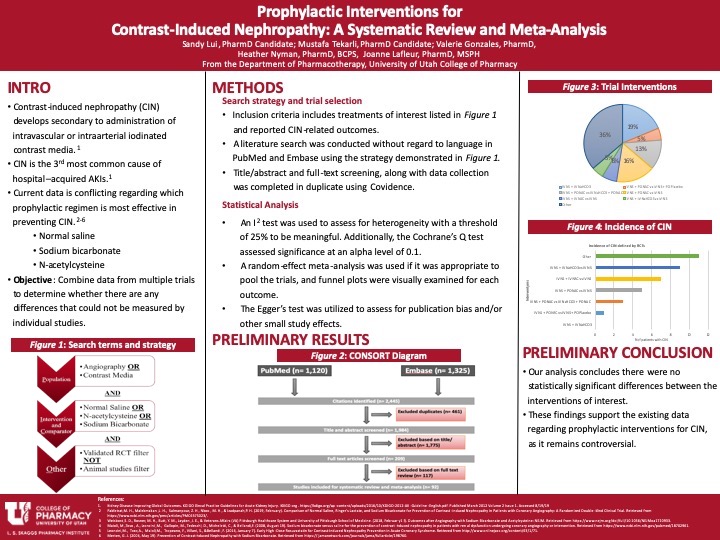INTRODUCTION
Current randomized control trials (RCTs) have reported conflicting findings for determining which prophylactic intervention is most effective for contrast-induced nephropathy (CIN). Iodinated contrast media, which play a key role in angiographic procedures, are associated with a decline in kidney function when administered to patients intravenously. Unfortunately, the decline in kidney function has been associated with an increase in mortality, morbidity and healthcare costs. The 3 most common prophylactic interventions for CIN include the volume expanders, normal saline (NS), and sodium bicarbonate (NaHCO3); and N- acetylcysteine, which has antioxidant and vasodilatory effects.
RESEARCH QUESTION
We aimed to conduct a pooled analysis comparing renal outcomes between these three regimens used for CIN prophylaxis.
STUDY DESIGN
Systematic review and meta-analysis of RCTs.
METHODS
An electronic literature search was conducted in PubMed and Embase, without regard to language, to identify RCTs that included patients who received IV NS, IV NaHCO3, and/or IV or oral N-acetylcysteine prior to undergoing an angiographic procedure with contrast media. Primary outcomes included the development of CI-AKI, as defined by each RCT. Title/abstract and full-text screening, along with data collection was completed in duplicate using Covidence. An I2 test will be used to assess for heterogeneity with a threshold of 25% to be meaningful. The Cochrane’s Q test will be used to assess significance at an alpha level of 0.1. Additionally, if it is appropriate to pool the trials, a random-effect meta-analysis will be used to estimate the pooled odds of experiencing CIN associated with each intervention compared to placebo and compared to each other. For each outcome, we will visually examine funnel plots, and conduct Egger’s tests to assess for publication bias and/or other small study effects.
RESULTS
We included 92 studies after title/abstract and full-text screening screening. Final results will be presented at completion of study.
CONCLUSIONS
Research in-progress
References
- Kidney Disease Improving Global Outcomes. KDIGO Clincal Practice Guidelines for Acute Kidney Injury. KDIGO.org. https://kdigo.org/wp-content/uploads/2016/10/KDIGO-2012-AKI-Guideline-English.pdf. Published March 2012 Volume 2 Issue 1. Accessed 8/19/19
- Shiel Jr., W. C., Jr., MD. (2017, January 25). Definition of Angiography. Retrieved October 12, 2020, from https://www.medicinenet.com/script/main/art.asp?articlekey=20588
- Mohammed, N. M. A., Mahfouz, A., Achkar, K., Rafie, I. M., & Hajar, R. (2013, July). Contrast-induced Nephropathy. Retrieved from https://www.ncbi.nlm.nih.gov/pmc/articles/PMC3969626/.
- Sharp AJ, Patel N, Reeves BC, Angelini GD, Fiorentino F. Pharmacological interventions for the prevention of contrast-induced acute kidney injury in high-risk adult patients undergoing coronary angiography: a systematic review and meta-analysis of randomised controlled trials. Open Heart. 2019;6(1):e000864.
- Weisbord, S. D., & Palevsky, P. M. (2011, May). Contrast-induced acute kidney injury: short- and long-term implications. Retrieved from https://www.ncbi.nlm.nih.gov/pmc/articles/PMC3143363/.
- Pakfetrat, M. H., Malekmakan, L. H., Salmanpour, Z. H., Nikoo, M. H., & Izadpanah, P. H. (2019, February). Comparison of Normal Saline, Ringer’s Lactate, and Sodium Bicarbonate for Prevention of Contrast-induced Nephropathy in Patients with Coronary Angiography: A Randomized Double-blind Clinical Trial. Retrieved from https://www.ncbi.nlm.nih.gov/pmc/articles/PMC6375023/.
- Weisbord, S. D., Rosner, M. H., Butt, Y. M., Layden, J. E., & Veterans Affairs (VA) Pittsburgh Healthcare System and University of Pittsburgh School of Medicine. (2018, February 15). Outcomes after Angiography with Sodium Bicarbonate and Acetylcysteine: NEJM. Retrieved from https://www.nejm.org/doi/full/10.1056/NEJMoa1710933.
- Maioli, M., Toso, A., Leoncini, M., Gallopin, M., Tedeschi, D., Micheletti, C., & Bellandi, F. (2008, August 19). Sodium bicarbonate versus saline for the prevention of contrast-induced nephropathy in patients with renal dysfunction undergoing coronary angiography or intervention. Retrieved from https://www.ncbi.nlm.nih.gov/pubmed/18702961.
- Leoncini, M., Toso, A., Maioli, M., Tropeano, F., Villani, S., & Bellandi, F. (2014, January 7). Early High-Dose Rosuvastatin for Contrast-Induced Nephropathy Prevention in Acute Coronary Syndrome. Retrieved from http://www.onlinejacc.org/content/63/1/71.
- Merten, G. J. (2004, May 19). Prevention of Contrast-Induced Nephropathy with Sodium Bicarbonate. Retrieved from https://jamanetwork.com/journals/jama/fullarticle/198760.




Responses
Sandy – do you mind sharing the higher resolution of the poster as I cannot see some details of the poster? Thanks.
Hi Dr. Nui,
Thanks for letting me know. When I changed the format to a JPEG, it must have messed with some of the details of my poster. Let me see if I can upload a more clear version.
Good work, Sandy. What is the most important thing you learned about conducting evidence synthesis type research?
Hi Dr. Witt! Thank you for your comment and question. The most important thing I learned about conducing evidence synthesis research is that it takes a team to be successful. There is a lot of time and efforts put into collecting the information, analyzing the data, and interpreting the results.
It sounds like there is not much difference between the preventative treatments. Do you know if there is much evidence that compares preventative treatments to none? Thanks!
Hi Dr. Henchey, thank you for your question. So far it does not seem that there is a difference in preventative treatments. There is data available comparing preventative treatment to none. Unfortunately, that data is also conflicting. I think it is difficult because there are many varying definition out there that investigators use to define CIN.
Critical subject. Especially in emergencies. Thank you.
Thank you, Jane!
Sandy, Like Dr. Chaiyakunapruk, I couldn’t see the data clearly when I expanded the poster, but your conclusions seem clear based on the bar graph I could make out. It will be so interesting to see the final conclusions of your work and that of Mustafa. Assuming the results hold, what would be the next step necessary for the findings to impact patient care?
Hi Dr. Keefe, I tried to upload a version with more clear resolution version yesterday, but I see it is in fact still blurry when it is expanded. I’ll look at the pixels again. The next step necessary for the findings to impact patient care would be to determine a more definitive definition of CIN and re-evaluate the impact of each intervention based off of what CIN is actually defined as.
Thank you for working on this analysis. I look forward to seeing your results. What have you observed our providers recommend in NCC?
Comments are closed.